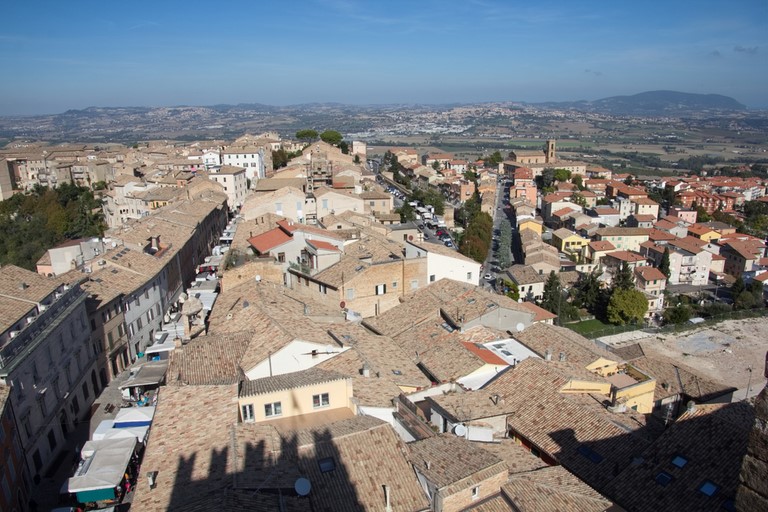Recanati - Sights and History
Sights

- Casa Leopardi: The house where the famous Italian poet Giacomo Leopardi was born and spent much of his life. The museum offers an insight into the poet's life and work.
- Colle dell'Infinito: A picturesque panoramic terrace immortalised in Leopardi's poem "L'Infinito". From here you have a breathtaking panoramic view of the Marche countryside.
- Duomo di Recanati with the sarcophagus of Pope Gregory XII: The cathedral of Recanati, built in Romanesque style and housing an impressive collection of religious works of art.
- Teatro Persiani: A historic theatre built in the 19th century and considered one of the most beautiful neoclassical theatres in Italy. Performances and events are held here regularly.
- San Domenico: A Gothic church with an impressive façade and ornate frescoes inside.
- Palazzo Comunale: The Recanati Town Hall, an imposing Renaissance building that impresses with its bell tower and beautiful interiors.
- Porta Marina: Porta Marina is a historic town gate and one of the landmarks of Recanati. It was built in the 17th century and served as the entrance gate to the town. The gate is made of solid stone and has an impressive architecture. It is a popular destination for tourists who want to explore the history and heritage of Recanati.
- Museo Civico Villa Colloredo Mels: The Museo Civico Villa Colloredo Mels is a museum housed in an impressive 18th century villa. It houses a variety of artworks, historical artefacts and archaeological finds from the region. Visitors can admire paintings, sculptures, antique furniture and other cultural treasures as they stroll through the villa's elegant rooms.
- Museo della Musica MUM & Museo Beniamino Gigli: The Museo della Musica MUM is a unique museum dedicated to music. It offers an extensive collection of musical instruments from different eras and cultures. Visitors can admire historical instruments, take part in interactive exhibitions and even enjoy concerts and musical performances. The museum also houses the Museo Beniamino Gigli, dedicated to the famous Italian opera singer who was a native of Recanati.
- Museo dell'Emigrazione Marchigiana: The Museo dell'Emigrazione Marchigiana is a museum dedicated to the history of emigration in the Marche region. It tells the stories and experiences of people who emigrated from the region to other parts of the world. The museum displays historical documents, photographs, personal objects and other exhibits from emigrants.
History

DThe origin of Recanati is not exactly known, but it is believed that it grew out of an ancient town called Helvia Recina, also called Ricina. After the destruction by the Goths in the 5th century, people fled to the hills, where Recanati gradually developed. The town was formed by the merger of several small towns on the hill, including Monte Morello, San Vito, Monte Volpino and Castelnuovo. The name Recanati probably derives from Ricina.
In the 12th century, Recanati became a Free Commune and adopted the system of podestà (a magistrate appointed by the town council who held the highest authority in the town for a limited term). In 1229, the city received coastal property and the right to build a harbour from the emperor. After a change of allegiance, Recanati returned to the papacy. In 1240, Pope Gregory IX raised the castle of Recanati to the status of a town and endowed it with a cathedral. In 1296 it became known that the chapel in Loreto contained the Holy House of Nazareth. Discord and conflict characterised the region, and in 1301 a constitution forbade revolts. Nevertheless, there were further clashes and wars.
The years from 1311 to 1315 were marked by serious conflicts in Recanati. The Guelfs and Ghibellines fought fiercely against each other. In 1312, Ghibelline nobles, supported by officials and councillors, attacked and plundered the properties of the Guelph bishop. The city fell into the hands of the Ghibellines, but after two years the Rector of the Mark forced them to surrender. However, a conspiracy led to bloody massacres of the Guelphs and the expulsion of the bishop. Further clashes between Guelfs and Ghibellines followed, with the Pope calling on the Guelfs to submit. Sieges, wars and destruction marked the period. In 1322 Recanati was conquered by the Guelfs, but the act of revenge by a leader led to the destruction of the town. Despite the damage, Recanati remained important. In the 15th century, the town was granted the right to mint coins. Pope Gregory XII settled here as a legate. Recanati became an important trading centre and attracted artists and scholars. The sculpture school of Recanatese and the gold and silversmith tradition developed. The apparition of the Blessed Virgin in 1456 led to the construction of the church of Santa Maria delle Grazie.
In 1798, Recanati was occupied by Napoleon's French troops. In the Risorgimento of 1831, the freedom patriot Vito Fedeli from Recanati lost his life. With the annexation of the Papal States to the Kingdom of Italy in 1860, Recanati became part of modern Italy. In 1937, the National Centre for Leopardi Studies was founded.